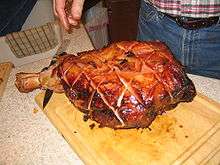Country ham
Country ham is a variety of heavily salted ham preserved by curing and smoking, associated with the cuisine of the Southern United States.[1] Used as a method of preservation from before widespread refrigeration, country ham is packed in a mixture of salts, sugar, and spices and allowed to cure for a long period of time, sometimes months, and often smoked afterwards. It is extremely dry and salty, often too salty to be palatable on its own. Most preparations call for a long soak (as long as a day or two) prior to preparation so that much of the salt can be removed and the ham rehydrated. Commercially available country hams may be sold whole as-is (often still wrapped in the net bags used to hang the hams during the smoking process), soaked but uncooked, or cooked and ready to eat. Country ham is often contrasted with wet-cured hams known as city ham in areas of the U.S. where both types of ham are available.
 Baked country ham | |
| Type | Meat |
|---|---|
| Course | Main course |
| Place of origin | United States |
| Similar dishes | Jinhua ham |
Country ham is a popular breakfast item in the southern U.S. It is often served in diners as a grilled steak, with the cross-cut portion of the leg bone still intact, alongside a portion of red-eye gravy, which is made by deglazing the pan used to cook the ham with black coffee and then reducing the resulting sauce. Country ham is also served as a biscuit sandwich in popular fast-food establishments across the southern U.S. as a convenient breakfast food.
Production
Country hams are salt-cured (with or without nitrites) for one to three months. They are usually hardwood smoked (usually hickory and red oak), but some types of country ham, such as the "salt-and-pepper ham" of North Carolina, are not smoked. Missouri country hams traditionally incorporate brown sugar in their cure mix and are known to be milder and less salty than hams produced in more eastern states such as Kentucky and Virginia. They are then aged for several months to 3 years, depending on the fat content of the meat.[2] Country hams are not fully cooked, but preserved by the cure. They are usually sold in stores unrefrigerated as whole, bone-in hams packaged in rough cotton bags, with identifying markings printed on the bags. Country ham is also sold in presoaked, sliced, ready-to-cook form, usually vacuum-packaged.
Preparation
There are several methods of cooking a country ham including slicing and pan-frying, baking whole, and simmering for several hours (in several changes of water). Whole hams may need to be scrubbed and soaked for several hours before eating to remove the salt cure and mold. Even when soaked, they are still quite salty. For traditionalists, part of the appeal of country ham is this highly salty taste. Some eaters of country ham scrub, scrape, or pare off the outer crust of curatives, slice it, pan fry it, and eat it as is. Or they may fry the ham with the crust on. Some discard the crust; others consume it along with the meat. Traditionalists, when frying the ham, will typically place it in a pan only long enough to lightly brown it on both sides and to warm the meat. Frying times as short as thirty seconds per side are not uncommon.
Fried country ham is often served as an entree as a whole slice, often with the femur cross-section left in. After the ham slice is fried and taken up, red-eye gravy is often made, by adding water or coffee to the pan drippings and cooking down for a short time. A ham steak is usually sliced about 3/8 inch thick.
Baked or boiled country ham is sliced paper thin and served with buttermilk (or similar) biscuits, beaten biscuits, or in yeast rolls, sometimes with butter or a sauce of melted butter and brown sugar. "Ham biscuits" (so-called whether in biscuits or rolls) are often found at church suppers and wedding receptions in the country ham area.
Trimming and scraps, the cooked bones, and the sawn-off hock are used for flavoring in the cooking of greens and pulses
Country ham is in some ways similar to Italian uncooked prosciutto (prosciutto crudo), but prosciutto is not smoked, and is usually moister than a country ham. It is also usually sliced much thinner than the thicker traditional country ham "steaks" or even slices for sandwiches.
In the United States, country ham is frequently used in recipes that call for Jinhua ham, which is not available in the US, due to USDA import restrictions.
See also
- Smithfield ham, Rays Country Ham, a type of country ham.
- List of hams
- List of dried foods
- List of smoked foods
References
- Nosowitz, Dan (December 24, 2016). "Check Out These Sick Hams From Around The World". Modern Farmer. Retrieved May 22, 2017.
- Kaminsky, Peter. (2005). Pig Perfect: Encounters with Remarkable Swine and Some Great Ways to Cook Them. Hyperion. 304 p. ISBN 1-4013-0036-7
Further reading
https://www.smokehouse.com/ham/country-ham.html
- Megan E. Edwards. "Virginia Ham: The Local and Global of Colonial Foodways". Food and Foodways 19 (Jan. 2011). pp. 56–73.